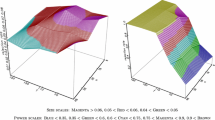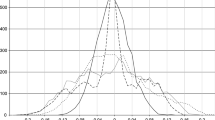Abstract
This paper is about the validity of established panel unit root tests applied to panels in which the individual time series are of different lengths, a case often encountered in practice. Most of the tests considered work well under various types of cross-correlation which is true for both, their application in balanced as well as in unbalanced panels. A Monte Carlo study reveals that in unbalanced panels, procedures involving the computation of individual \(p\)-values for each cross-section unit (or the combination thereof) are mostly superior to those relying on a pooled Dickey–Fuller regression framework. As the former are able to consider each unit separately, they do not require cutting back the “longer” time series so as to obtain the smallest “balanced” quadrangle which in turn means that no potentially valuable information is lost.
Similar content being viewed by others
Notes
Cf. Breitung and Pesaran (2008).
A homogeneous alternative as e.g. in Breitung and Das (2005) involves the danger of misinterpreting the rejection of the panel unit root null as one might then conclude that the whole panel is stationary. These tests, however, have also power against mixed panels in which only a subset of the \(N\) cross-section units is stationary.
For obtaining critical values for some \(N\) and \(T\) lying between the tabulated ones, linear interpolation will be used.
Cf. (Hartung (1999), p. 850).
In the simulation part of the present paper, \(\lambda _i\) weights the probit of each unit according to the length of its time series relative to the the sum of all observations in time in the panel such that \(\sum _{i=1}^N \lambda _i = 1\) in unbalanced panels. In balanced panels, \(\lambda _i=1\) such that all units are equally weighted.
Cf. Sarkar (1998) for more details.
Cf. Hanck (2013).
Note that, due to space considerations, only the results of the modified version of Pesaran (2007) test (\(C^*\)) are reported in the subsequent tables.
For this purpose the experiment by Hanck (2013) was replicated under the same setup as for unbalanced panels. Results are available upon request.
Equicorrelation has also been considered as another form of cross-correlation. The results are not reported due to the fact that they do not alter the conclusions reached.
Due to space considerations, results for \(\varvec{\phi }_N=(\varvec{\iota }^{\prime }_{3/4N}, \widetilde{\varvec{\phi }}^{\prime }_{N/4})^{\prime }\) are not presented in a table.
For reasons of brevity, the results for the case of zero intercepts are not reported in the following. The size results are rather similar to those given; unsurprisingly, the power decreases when a constant is included in the regression.
As it is a first generation panel unit root test not accounting for cross-correlation, \(P_{\chi ^2}\) is severely oversized for all types of correlation which is why power results will not be reported for this test.
Table 2 Power results and relative changes for homogeneous panels, \(\varvec{\phi }_N=0.95\cdot \varvec{\iota }_N\) Table 3 Power results and relative changes for heterogeneous panels, \(\varvec{\phi }_N=\widetilde{\varvec{\phi }}_N\) Table 4 Power results and relative changes for partially stationary heterogeneous panels, \(\varvec{\phi }_N=(\varvec{\iota }^{\prime }_{N/2}, \widetilde{\varvec{\phi }^{\prime }}_{N/2})^{\prime }\)
References
Bai, J., Ng, S.: A PANIC attack on unit roots and cointegration. Econometrica 72, 1127–1177 (2004)
Breitung, J., Das, S.: Panel unit root tests under cross-sectional dependence. Statistica Neerlandica 59, 414–433 (2005)
Breitung, J., Pesaran, M.H.: Unit roots and cointegration in panels. In: Matyas, L., Sevestre, P. (eds.) The Econometrics of Panel Data: Fundamentals and Recent Developments in Theory and Practice, 3rd edn, pp. 279–322. Kluwer Academic Publishers, Dordrecht (2008)
Demetrescu, M., Hassler, U., Tarcolea, A.-I.: Combining significance of correlated statistics with application to panel data. Oxford Bull. Econ. Stat. 68, 647–663 (2006)
Fisher, R.A.: Statistical Methods for Research Workers, 12th edn. Oliver and Bond, Berlin (1954)
Hanck, C.: An intersection test for panel unit roots. Econometric Rev. 32, 183–203 (2013)
Hartung, J.: A note on combining dependent tests of significance. Biometrical J. 41, 849–855 (1999)
Hommel, G.: A stagewise rejective multiple test procedure based on a modified Bonferroni test. Biometrika 75, 383–386 (1988)
Im, K.S., Pesaran, M.H., Shin, Y.: Testing for unit roots in heterogeneous panels. J. Econometrics 115, 53–74 (2003)
Levin, A., Lin, C.-F., Chu, C.-S.J.: Unit root tests in panel data: asymptotic and finite-sample properties. J. Econometrics 108, 1–24 (2002)
MacKinnon, J.G.: Numerical distribution functions for unit root and cointegration tests. J. Appl. Econometrics 11, 601–618 (1996)
Maddala, G.S., Wu, S.: A comparative study of unit root tests with panel data and a new simple test. Oxford Bull. Economics Stat. 61, 631–652 (1999)
Moon, H.R., Perron, B.: Testing for a unit root in panels with dynamic factors. J. Econometrics 122, 81–126 (2004)
Moon, H.R., Perron, B.: Beyond panel unit root tests: using multiple testing to determine the nonstationarity properties of individual series in a panel. J. Econometrics 169, 29–33 (2012)
Pesaran, M.H.: A simple panel unit root test in the presence of cross-section dependence. J. Appl. Econometrics 22, 265–312 (2007)
Phillips, P.C.B., Sul, D.: Dynamic panel estimation and homogeneity testing under cross section dependence. Econometrics J. 6, 217–259 (2003)
Sarkar, S.K.: Some probability inequalities for ordered \(\rm {MTP}_2\) random variables: a proof of the Simes conjecture. Annals Stat. 26, 494–504 (1998)
Simes, R.J.: An improved Bonferroni procedure for multiple tests of significance. Biometrika 73, 751–754 (1986)
Westerlund, J., Breitung, J.: Lessons from a decade of IPS and LLC (forthcoming in Econometric Reviews) (2012). doi:10.1080/07474938.2013.741023
Author information
Authors and Affiliations
Corresponding author
Additional information
I thank Jörg Breitung, Christoph Hanck, Uwe Hassler and Jan Schneemeier for their helpful comments. I also thank two anonymous referees for their useful remarks which have helped to improve the paper.
Rights and permissions
About this article
Cite this article
Werkmann, V. Performance of unit root tests in unbalanced panels: experimental evidence. AStA Adv Stat Anal 97, 271–285 (2013). https://doi.org/10.1007/s10182-012-0203-8
Received:
Accepted:
Published:
Issue Date:
DOI: https://doi.org/10.1007/s10182-012-0203-8




